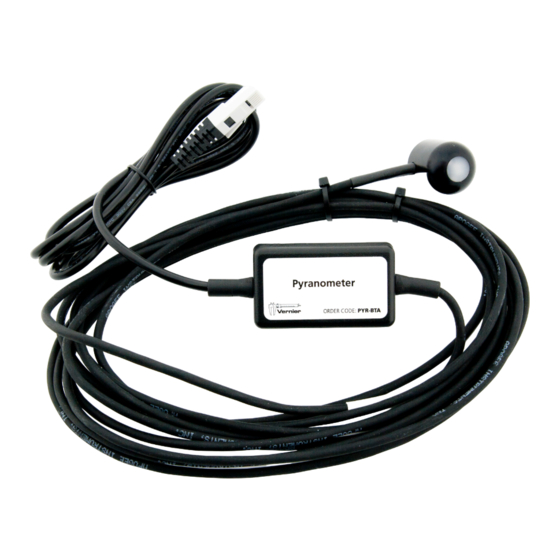
Advertisement
Quick Links
Pyranometer
(Order Code PYR-BTA)
The Vernier Pyranometer measures the
power of electromagnetic radiation in
watts per square meter. It is sensitive to
the near infrared, visible, and UV ranges,
where nearly all of the solar energy is
concentrated. It is great for experiments with solar cells and calculating their
efficiency. The sensor is weatherproof and has a dome-shape top to allow it to
work with a wide range of sun angles. The Pyranometer has a 6 m cable.
An ideal pyranometer measures the entire solar spectrum, 280 to 2800 nm.
However, about ninety percent of sunlight energy is in the wavelengths between
300 and 1100 nm. The Vernier Pyranometer detects all of this energy.
The Vernier Pyranometer is cosine corrected and is designed to maintain its
accuracy when radiation comes from different angles. The cosine response when
the sun is at 75° to the zenith is ± 5 percent. Zenith angles greater than 75°
contribute less than 3 percent of daily radiation.
Spectral response of the Vernier Pyranometer
Note: Vernier products are designed for educational use. Our products are not
designed nor are they recommended for any industrial, medical, or commercial
process such as life support, patient diagnosis, control of a manufacturing
process, or industrial testing of any kind.
What's Included
Vernier Pyranometer
l
Cover for the lens of the Pyranometer
l
Compatible Software
See
www.vernier.com/manuals/pyr-bta
Vernier Pyranometer.
for a list of software compatible with the
Getting Started
1. Connect the sensor to the interface (LabQuest Mini, LabQuest 3, etc.).
2. Start the appropriate data-collection software (Vernier Graphical Analysis
®
LabQuest
App, or Logger Pro™) if not already running, and choose New
from File menu. The software will identify the sensor and load a default
data-collection setup. You are now ready to collect data.
If you are collecting data using a Chromebook™, mobile device such as iPad
Android™ tablet, or a Vernier wireless interface, please see the following link for
up-to-date connection information:
www.vernier.com/start/pyr-bta
Using the Product
Mounting the Pyranometer
The Pyranometer is designed to be permanently mounted outside. It is
weatherproof and has a lens to work with a wide range of sun angles. The sensor
is designed for continuous outdoor use. The black electronics box should be kept
dry.
The Pyranometer should be mounted with the white lens pointing straight up and
with the cord pointing toward the north (if you are in the Northern Hemisphere) or
toward the south (if in the Southern Hemisphere).
The nylon 10–32" × 3/8" mounting screw can be used for attaching the
Pyranometer to a solid object.
Videos
View videos related to this product at
Calibrating the Sensor
This Pyranometer was calibrated before shipping and should not need user
calibration. It was calibrated over a multiple day period by comparison to a heated
and ventilated Kipp & Zonen model CM21 precision reference radiometer.
Optional Calibration Check:
Our Pyranometer should never need calibration, but if you want to verify that the
calibration is correct, you can check it using a Clear Sky Calibration. The concept
involved here is that if you know your latitude, longitude, altitude, time of day, air
temperature, and humidity, you should know the irradiance on a day with a totally
clear sky (no clouds or pollution). If you have a clear sky day and you can get all
the information, visit
www.clearskycalculator.com
This site will offer you a web application that will calculate the irradiance in Watts
per square meter, assuming a completely clear sky. Complete the required fields
and you will get a reading, which you can compare with the Pyranometer reading.
Repeat at several times near solar noon and over several days, if possible. If the
reading from the Pyranometer is consistently lower than the Clear Sky Calculator
value, the Pyranometer may need to be cleaned or re-leveled. If that does not
correct the problem, contact Vernier Software & Technology.
1
www.vernier.com/pyr-bta
®
,
®
or
Advertisement

Summary of Contents for Vernier PYR-BTA
- Page 1 If you are collecting data using a Chromebook™, mobile device such as iPad where nearly all of the solar energy is Android™ tablet, or a Vernier wireless interface, please see the following link for concentrated. It is great for experiments with solar cells and calculating their up-to-date connection information: efficiency.
- Page 2 (high temperature 39ºC or 102ºF). We Designed for continuous outdoor use monitored the current through the circuit with a Vernier High Current Sensor The sensor can be submerged in water. (HCS-BTA) and the voltage with a Vernier 30-Volt Voltage Probe (30V-BTA).
- Page 3 If you have watched the related product video(s), followed the troubleshooting steps, and are still having trouble with your Vernier Pyranometer, contact Vernier Here are some sample results from an experiment with a small photovoltaic cell Technical Support at support@vernier.com or call 888-837-6437. Support...
- Page 4 • www.vernier.com Rev. 2/26/2024 Vernier Graphical Analysis, LabQuest, LabQuest Mini, Logger Pro, and other marks shown are our trademarks or registered trademarks in the United States. iPad is a trademark of Apple Inc., registered in the U.S. and other countries.
















Need help?
Do you have a question about the PYR-BTA and is the answer not in the manual?
Questions and answers